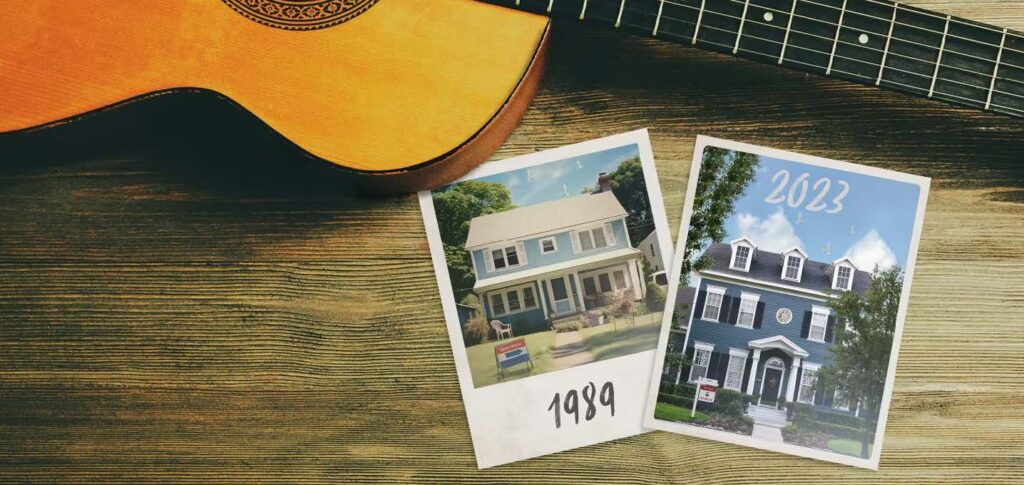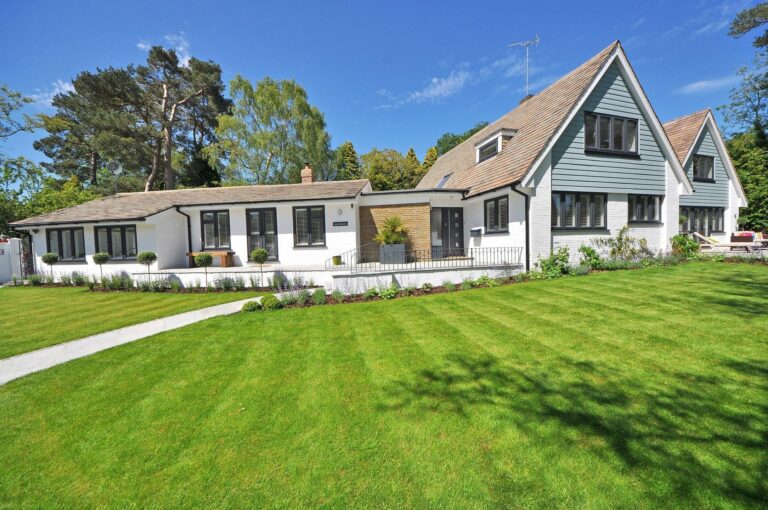
Some homes are “suburban legends” that offer “blank space” for the next generation of buyers to make their own. Learn from experts about housing trends, then and now.
The events of 1989 captivated the world. It was a year of change as the end of the decade saw the fall of the Berlin Wall, marking the symbolic end of the Cold War. It was also a year of innovation. NASA launched the Galileo spacecraft to study Jupiter, the first commercial internet service providers were established, the proposal for the World Wide Web was submitted, and the first 24 satellites on the Global Positioning System were placed into orbit.
Pop culture flourished, too. “The Simpsons” debuted, becoming one of the longest-running TV shows ever. Tim Burton’s “Batman” movie, featuring Michael Keaton and Jack Nicholson, achieved box office success. And without yet knowing it, one of the most influential popstars in the world, Taylor Swift, was born on December 13th.
Reflective of what was happening globally, the 1989 housing market presented challenges and opportunities. Real estate had surged in the decade prior, offering existing homeowners a positive increase in home value. However, fluctuating interest rates and rising sale prices deterred some potential buyers from entering the market.
We rounded up insight from agents who have been in business since 1989 or before about how that era of real estate compares to today. Here’s what they had to say:
• Anthony Askowitz, Broker/Owner of RE/MAX Advance Realty and RE/MAX All Keys Real Estate in Miami, Florida, began his real estate career in 1989.
• Lyn Donley, Broker of RE/MAX Executive in Waynesville, North Carolina, started in real estate in 1985 in Fort Lauderdale, Florida.
• Lynne Gormley, Broker/Sales Associate at RE/MAX Heritage Properties in Chester, New Jersey, began her real estate career in 1984.
• Sylvia Hefferon, Team Leader of the Hefferon-Edwards Team at RE/MAX Executive in Charlotte, North Carolina, became an agent in 1980 after moving to Charlotte.
How has the real estate industry evolved?
Askowitz: When I got my real estate license back in 1989, it was a different era. We had no cell phones and your beeper was the best way for clients to communicate with you. When the beeper went off, you had to find a pay phone and put in 25 cents to speak now. There was no computerized MLS system. We would receive one book every two weeks with all the “current” listings for all 50 agents in the office to share. Contracts were on one page with carbon paper so when we wrote in the blank spaces the ink would go through to the other pages. We had to just shake it off. The new kid on the block was a fax machine. Boy did that save time and make communication swift. Since then, everything has changed.
Donley: The advent of the internet has revolutionized our business. Buyers no longer depend on us to find properties for them. Now, our job is to negotiate like a professional, shepherd our clients through the selling and buying process, and counsel them on location. We must keep up with social media trends, marketing, and the latest apps. Being “tech-savvy” is essential for today’s agent.
I believe that agents have a better reputation now than they did “back in the day.” We are considered professionals in our field. There’s no “waiting until tomorrow” to respond to a text or email. We’re on call 24/7, and we’d better be ready to jump.
Gormley: I don’t believe the real estate industry has changed much over the last 33 years, but how you conduct your business has changed with the internet. There is no need for print media, photographs by agents to MLS associations, newspaper ads, faxing copies or showing “The Book” to prospects. Technology and smartphones have increased the productivity of real estate professionals and have made it easier for buyers and sellers to search for homes, compare mortgages, and search for specific neighborhoods ahead of a call to an agent. The expertise of agents remains vital to the home buying and selling process. The one constant in real estate is that it’s a people business, so you must stay in touch, “nose to nose – toes to toes,” past and present.
Hefferon: I think the biggest change in the last 33 years has been the internet. Buyers and sellers have so much information readily accessible to them at any given time. The information is not always reliable, but buyers and sellers are a lot more educated on the market and look for an agent to show them homes they have found and to negotiate for them and get to the closing. I used to put buyers in my car and ride them around for the day, but now they are able to eliminate homes by touring on the internet.
Cell phones have also made a big difference in the industry. I was the first agent in Charlotte to get one – it was huge, and my bill was over $700 per month. It still was so much better than stopping at pay phones. Overall, the market is so much better now to be able to take care of my buyers and sellers with all the information we have access to and to give the best service we can.
What were the main market forces?
Askowitz: At that time, most loans were freely assumable. That’s when interest rates were around 16%-17%. So, assumable mortgages were a huge advantage to home buyers.
Donley: When I started selling real estate in 1985, the interest rates were 18%. Everyone went out to refinance their homes when the rates dropped to 10%.
Gormley: In 1989, there was an overabundance of new and resale homes on the market, and interest rates were approximately 10.32%. The median resale price of a home in the Long Valley area was $225,000 – $260,000. At the same time, there were many developers offering new homes in new sub-divisions ranging from the low $300,000s for larger homes to very large luxury homes priced at over $1,000,000. However, new homes were not an easy market in 1989 and some builders were reducing prices and/or offering enticing incentives to move-up buyers to purchase their homes.
Hefferon: In 1989, the market had improved somewhat but interest rates were still between 10%-11%. Buyers were anxious to get out and purchase a home with the lower interest rates, but the inventory had decreased somewhat. There was owner financing still going on with the buyers getting a mortgage and the sellers doing a second mortgage on their home to get it sold. We saw some creative financing during that time.
What were the most popular home styles?
Askowitz: In South Florida, the most popular home style was Mediterranean.
Donley: Without a doubt, the ranch home was most popular with the average consumer in the late 1980s. People were renovating their 1960s and 1970s homes to remove their avocado green and harvest gold appliances. The ceilings were still 8 feet, and the garages – if they had one – were one or two-car max. The “Phony Coloney” (imitation brick Colonial reproductions) became popular in the suburbs for more affluent buyers. People wanted a façade that looked “rich.” Like today, everyone in 1989 wanted an updated kitchen and bath. Never mind that an updated kitchen meant formica counters and white appliances. As we all know, kitchen and bathroom styles come and go.
Gormely: The most popular style in 1989 was a two-story colonial with a two-story foyer and a two-story family room with 9-foot ceilings, and lots of windows on the first floor. There was a lot of new home construction. Buyers wanted larger homes, more living space, open areas from kitchen to family room, more volume and larger play areas for the children.
Hefferon: The homes that were most popular were the true traditional homes with large arched windows above the front door. Now when I see homes like that, I can tell you what year it was built. The home did not really have open floor plans. Buyers were looking for large yards to enjoy. Now, some buyers are opting for very small yards to be able to afford the home they want.
How does the 1989 market compare to today?
Askowitz: Prices in Miami have skyrocketed so that a house that would sell in 1989 for $500,000 might now sell for over $10 million in 2023.
Donley: The average home in my area in those days would sell in the $200,000 range and $300,000 if it were renovated. Today there is a home for sale in Fort Lauderdale for over $29 million.
Gormley: In 2023, the housing prices are much higher, the inventory is lower, and interest rates are rising. Today, we have the highest ratio of home price to income that we have seen for more than 33 years. This is an affordability and availability issue.
While trends come and go, interest rates fluctuate, and the world keeps on turning, one thing remains true across decades: People continue to pursue homeownership for enjoyment, and as a way to build generational wealth.
If you’re looking to buy a home in 2023, it’s helpful to have an experienced professional on your side. For buyers looking to make their wildest dreams of homeownership come true, contact a local RE/MAX agent today.
[1] Freddie Mac: “Primary Mortgage Market Survey”
[2] U.S. Census Bureau “Median and Average Sales Price of New Homes Old In United States”
[3] U.S. Census Bureau “New Houses Sold”
Article originally appeared on RE/MAX.com.







